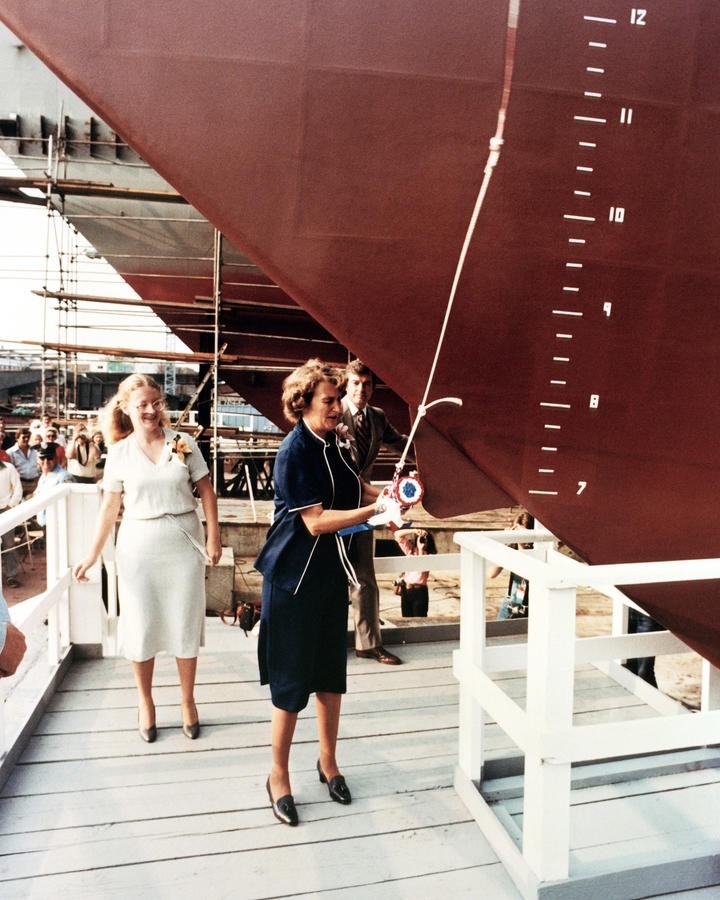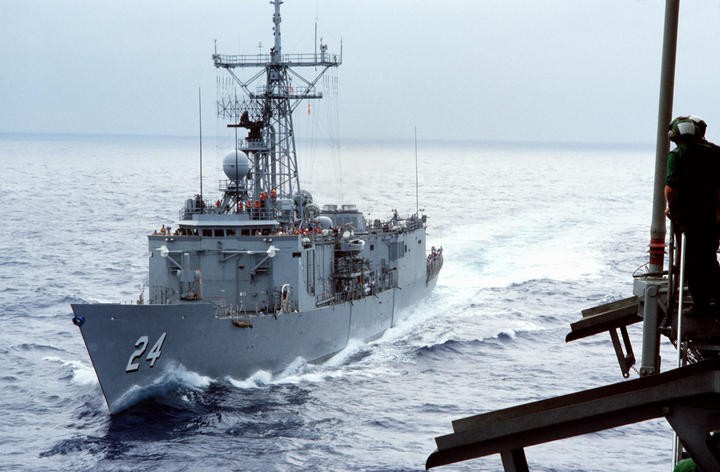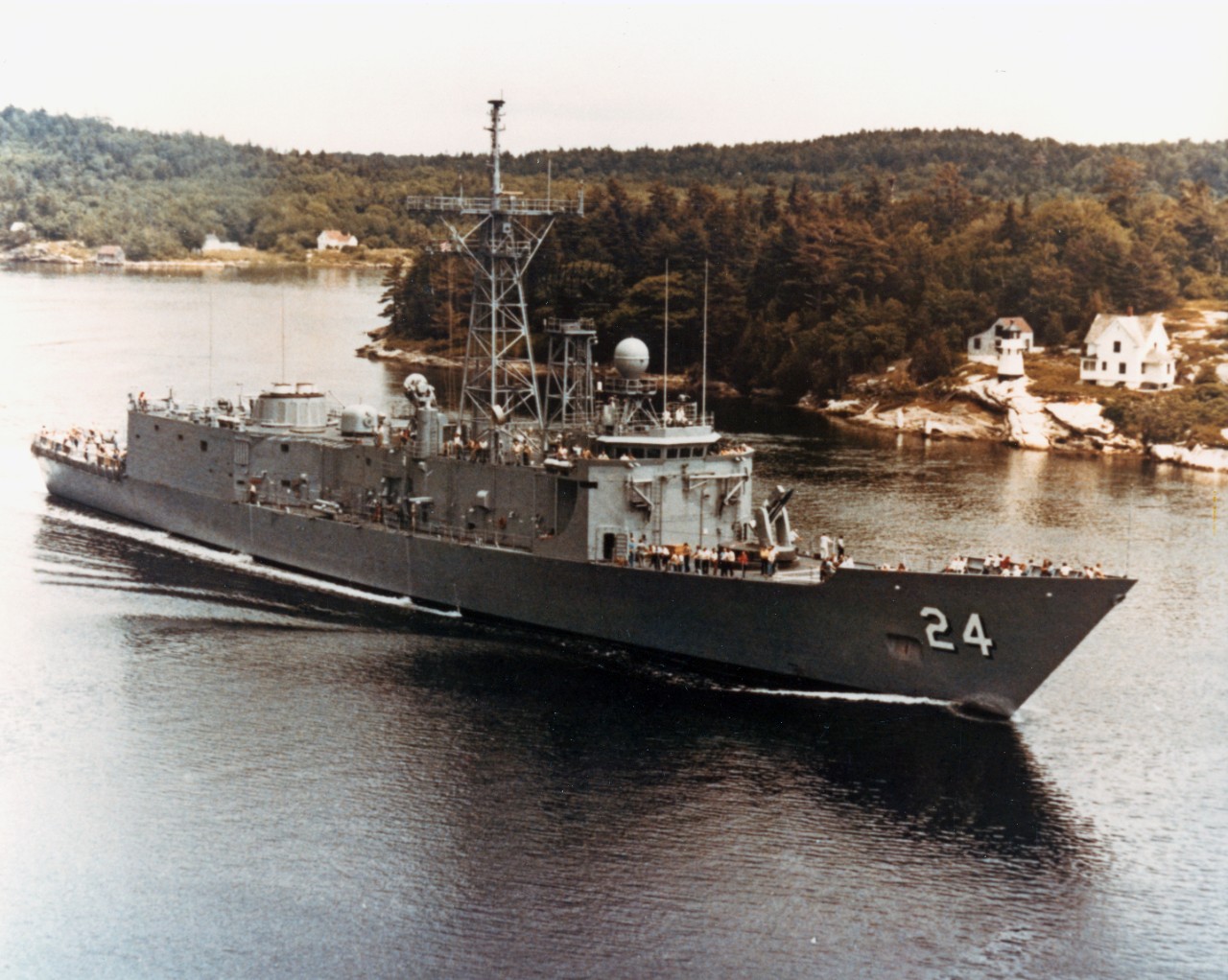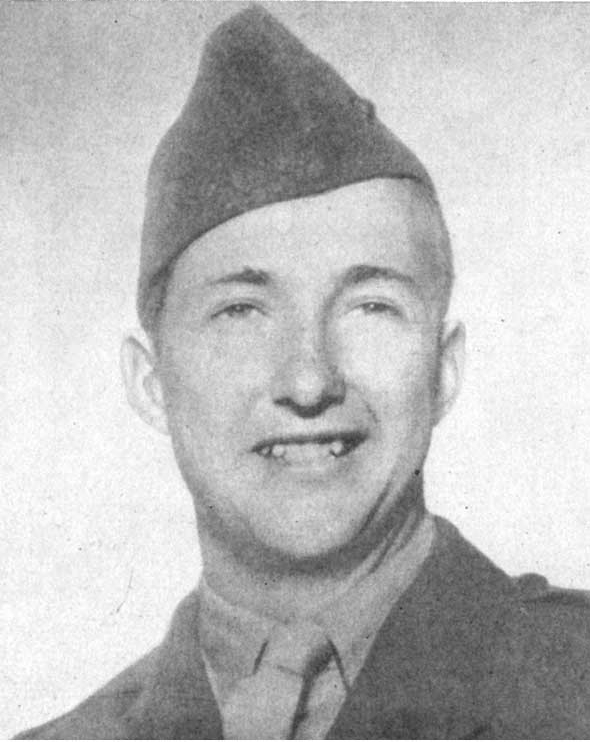USS Jack Williams (FFG-24)
1981–1996
Jack Williams was born in Harrison, Arkansas, on 18 October 1924, to William and Dorothy (Daughty) Lee Williams. Prior to graduating from high school, Williams eagerly registered for the draft on 23 December 1942. He fulfilled a childhood ambition by joining the U.S. Navy, enlisting upon his graduation. After basic training at Naval Training Station, San Diego, Calif., he arrived at the U.S. Naval Hospital Corps School at Naval Hospital, San Diego, for corpsman training, graduating and receiving a promotion to Hospital Apprentice First Class on 1 November 1943.
Upon graduation, Williams performed hospital orderly duties at the naval hospital before receiving assignment on 31 January 1944 to the Field Medical School Battalion Training Center at Camp Elliot, in order to learn how to treat combat wounds. Finishing in March with an 85 percent average in the courses, “Arkie” (as his Marine friends knew him) received transfer to 2nd Platoon, H Company, 3rd Battalion, 28th Marine Regiment (3/28), 5th Marine Division at Camp Pendleton, Calif., in May 1943. Shipped out to the Pacific, the 5th Marine Division assaulted the Japanese stronghold of Iwo Jima on 19 February 1945.
Halftone reproduction of a photograph, copied from the official publication Medal of Honor, 1861-1949, The Navy, page 280. Pharmacist's Mate Third Class Jack Williams received the Medal of Honor, posthumously, for conspicuous gallantry and intrepidity at the risk of his life on 3 March 1945, during the Battle of Iwo Jima. U.S. Naval History and Heritage Command photograph. Catalog#: NH 84958-A.
On 3 March 1945, H Company moved into rugged terrain to engage the Japanese forces. Having already aided over a dozen wounded Marines, Pharmacist’s Mate 3rd Class (PhM3c) Williams ran into no man’s land to help wounded Marine PFC James “Red” Naughton. According to his Medal of Honor citation, Williams moved forward under “intense enemy small-arms fire” and dragged his wounded friend to a nearby shallow depression to administer morphine and first aid. Shielding Naughton’s body with his own, PhM3c Williams was suddenly “struck in the abdomen and groin three times by hostile rifle fire.” Amazingly, Williams had the presence of mind to continue to provide aid to PFC Naughton before dressing his own wounds. While attempting to make his way back to friendly lines, PhM3c Williams came across another wounded Marine and again provided aid. After leaving the wounded man in the care of another corpsman, a Japanese sniper shot and wounded Williams again. He died of his wounds later that day.
(FFG-24; displacement 3,109 tons; length 408'; beam 45' 4"; draft 24' 6"; speed 29 knots; complement 219; armament 76-millimeter, 2 triple tube antisubmarine torpedo mounts, Guided Missile Launching System with Standard surface-to-air missiles, Harpoon surface-to-surface missiles, two SH-2 LAMPS multipurpose helicopters; class Oliver Hazard Perry).
Jack Williams (FFG-24) was laid down on 25 February 1980, at Bath, Maine, by the Bath Iron Works Corp.; launched on 30 August 1980 and sponsored by Mrs. Fern Williams Carr, sister of PhM3c Williams; and commissioned on 19 September 1981, Cmdr. Hugh E. Carroll in command.
She commenced her shakedown phase with a transit to Mayport, Fl. (21 September-2 October 1981), before holding refresher training off Guantánamo Bay, Cuba (3-21 October). The guided missile frigate began missile exercises in the Caribbean on 8 February 1982. After a port visit to St. Thomas, Virgin Islands, she proceeded to Roosevelt Roads, Puerto Rico, to conclude the missile exercises (11-15 February). Jack Williams also made a stop in New York City for Fleet Week 82 (26 March-29 March).
On 2 April 1982, Jack Williams arrived at the Bath Iron Works to have a new SLQ-32 electronic warfare (EW) system installed. After returning to Mayport, she got underway to conduct training exercises off Cuba (10-13 October). She then proceeded to the Bahamas to begin anti-submarine (ASW) training (8-11 November).

Fern Williams Carr, co-sponsor, breaks a bottle of champagne across the bow of the Oliver Hazard Perry class guided missile frigate Jack Williams (FFG-24) at the conclusion of the launching ceremony, 30 August 1980. VIRIN: DN-SC-85-04291
While en route to Norfolk, Va., Jack Williams responded to an urgent signal from merchant vessel Marine Electric, taking on water in heavy seas. Arriving to the area several hours after the vessel sank, the guided missile frigate searched for survivors in the cold sea but could locate none. After a short in-port period, Jack Williams made way for Readiness Exercise 1-83 off Puerto Rico.
Jack Williams steamed on her first overseas deployment (29 April-10 November 1983), joining Battle Group Dwight D. Eisenhower (CVN-69). Serving as a radar picket ship while in the Persian Gulf, she received assignment as an anti-air warfare defense vessel for battleship New Jersey (BB-62). Her re-assignment brought her into Task Force (TF) 61, stationed off Beirut, Lebanon. On 23 October, terrorists drove a truck laden with explosives into the U.S. Marine Corps barracks in Beirut, killing over 230 Marines. After sending a team ashore the next day to help aid in rescue and clean-up operations, the guided missile frigate remained on the gun line until relieved on 4 November.
After crossing the Arctic Circle on 10 March 1984, Jack Williams performed operations in Norwegian fjords supporting Exercise TEAMWORK (15-19 March). She then began a series of port visits, beginning with Kiel, Germany (27 March-2 April); Helsinki, Finland (5-9 April); and Aarhus, Denmark (14-17 April). After transiting from Denmark to Mayport (12-29 April), Jack Williams began restricted availability (27 June-28 August) at her homeport. Getting underway for the Panama Canal (14-17 December), the guided missile frigate began counter-narcotics operations in the Eastern Pacific at the end of the month.
Continuing counter-narcotics operations through January 1985, Jack Williams arrived back to Mayport on the 23rd. From 27-29 April, she participated in Exercise UNIVERSAL TREK 85 and COMPUTEX 3-85 (9-15 June). On 2 October, the guided missile frigate got underway for an around-the-world deployment with Battle Group Coral Sea (CV-43). After a port visit to Haifa, Israel (30 October-12 November), Jack Williams participated in ASW exercises in the North Arabian Sea. She initiated pollywogs into shellbacks after crossing the Equator and entering King Neptune’s realm on 15 December.
After spending the holidays in Phuket, Thailand (23-29 December 1985), Jack Williams proceeded to the South China Sea to participate in PASSEX (12 January 1986). After making way and transiting the Suez Canal (9-15 February), she began a series of port visits in the Mediterranean, including Catania, Sicily (16-20 February); Palermo, Sicily (25-26 February); Gaeta, Italy (28 February-9 March); Genoa, Italy (12-18 March); and Cavalaire-sur-Mer, France (3-6 April). Serving as a defense vessel for Coral Sea, she participated in operations off Libya (14-19 April) before making a final port visit to Taormina, Sicily (21-25 April). The Coral Sea battle group steamed for home, arriving at Mayport on 19 May.
Jack Williams entered the Atlantic Dry Dock Co., for a scheduled upkeep period (7 January-7 May 1987). After conducting sea trials off Mayport (14-16 May), she got underway for Roosevelt Roads for a missile shoot (1-2 July). The guided missile frigate steamed into the Caribbean before making port visits to St. Croix (2-3 July) and St. Martin (12-14 July). After an upkeep period at Mayport, Jack Williams got underway for Savannah (23-26 October) and St. Martin (6-9 November). After a brief port visit to Newport, R.I., (17-18 November) she made way to Mayport to begin pre-deployment training.
After completing her pre-overseas movement (POM) period the first week of January 1988, Jack Williams got underway for a Middle East deployment (11 January-9 July). The guided missile frigate transited the Straits of Hormuz on 14 February, and made a port visit to Mina Sulman, Bahrain (15-16 February). After a ten-day underway period, she anchored at Bahrain for a short upkeep period (1-7 March). Getting underway for patrol operations in the Persian Gulf (19-30 April), she later conducted turnover with frigates Bradley (FF-1041) and Fahrion (FFG-22) off Djibouti on 3 June.
Jack Williams began the New Year 1989 at her homeport in Mayport. After holding sea trials off the coast of Florida (6-9 February), the guided missile frigate steamed en route to Guantánamo Bay for refresher training (10-13 February). Jack Williams began her POM period in late June before deploying to the Middle East on 11 July, steaming through the Suez Canal on the 31st. Participating in operations with Battle Group America (CV-66) from 12-13 August, she also received orders to patrol the Persian Gulf on three separate occasions (17-29 August; 15-17 September; and 25-30 September). After turnover with guided missile frigate Carr (FFG-54) on 5 December, Jack Williams conducted a PASSEX with the Saudi and Egyptian navies (11-12 December) before returning to Mayport on 12 January 1990.
A much-needed upkeep and stand-down period occurred from 13 January-26 February 1990. On the 27th, Jack Williams got underway for training in the Jacksonville operating area. Steaming to the Caribbean, the crewmembers enjoyed five days of leave at St. Martin (2-7 May). Upon return to Mayport, she prepared for a Dry Dock Selective Restrictive Availability (DSRA) period at the Derector Shipyard in Newport (28 June-28 October). Returning to Mayport on 31 October, the guided missile frigate got underway for three weeks of counter-narcotics operations in the Caribbean (9-29 November).

Port bow view of the guided missile frigate Jack Williams (FFG-24) coming alongside the aircraft carrier John F. Kennedy (CV-67) in preparation of refueling operations, 15 June 1984. VIRIN: DN-ST-85-02630
Spending the holiday leave period in Mayport until 13 January 1991, Jack Williams made way to the Jacksonville operations area for Type Commander’s training (14-18 January). While steaming again in March, she rescued three passengers from sailboat Nyeema (7 March) after the crew reported engine trouble. The guided missile frigate resumed steaming in the Caribbean while conducting counter-narcotics operations for the rest of the year, often making short port visits to either Guantánamo Bay or Roosevelt Roads to take on fuel and supplies.
After conducting an emergency tow with tug Paiute (ATF-159) on 9 February 1992, Jack Williams prepared for a six-month deployment to the Mediterranean Sea/Red Sea. Departing on 6 May, she entered the Sixth Fleet area of operations on the 17th and proceeded to the Suez Canal, transiting on 22-23 May. Jack Williams made port visits to Hurghada, Egypt (16-19 June); Cadiz, Spain (3-6 July); Lisbon, Portugal (10 July); Augusta Bay, Italy (9-10 August); and Athens, Greece (18 August).
Underway on 31 August 1992, Jack Williams steamed back to the northern Red Sea for maritime interception operations (MIO) in support of United Nations sanctions against Iraq until 17 October. On 21 October, while underway in the eastern Mediterranean, Jack Williams made history by becoming one of the first U.S. warships to conduct a PASSEX/light line transfer with naval vessels of the former Soviet Union. Along with Stephen W. Groves (FFG-29), the two U.S. guided missile frigates steamed alongside Admiral Panteleyev (DDG-467), an Udaloy-class guided missile destroyer, and Bespokyny (LST-131), a Rapouch-class landing, tank, ship. Jack Williams conducted a light line transfer with Bespokyny, while Stephen W. Groves did the same with Admiral Panteleyey. After 190 days underway, Jack Williams arrived at her homeport on the morning of 6 November.
Shifting to her new homeport at Pascagoula, MS., on 25 January 1993, Jack Williams underwent a restricted availability period (28 January-31 May). Getting underway in mid-June for training in the Gulf of Mexico operations area, the guided missile frigate conducted numerous training exercises throughout the year, including COMPUTEX 2-93, with Battle Group Saratoga (CV-60) from 7-15 October. Ordered to detach from the battle group, Jack Williams got underway en route to Haiti to participate in Operation SUPPORT DEMOCRACY (17 October-6 November).
After the holiday stand-down period in December 1993, Jack Williams steamed again for the Haiti area of operations (10 January-24 February 1994). On 16 January, the frigate rescued a Haitian mariner, Michael Hermes, from a sailboat struggling in heavy storms. Brought on board using a sling, Hermes’ boat later sank. The next day, after transferring the mariner to a U.S. Coast Guard cutter, Jack Williams participated in an ASW exercise with Sunfish (SSN-649). Jack Williams later received the Battle ‘E’ Efficiency award from Commander, Destroyer Squadron (ComDesRon) 8 in February.
On 5 August 1994, Stout (DDG-55) moored next to Jack Williams, marking the first time an Arleigh Burke-class destroyer moored pier side at Naval Station Pascagoula next to an Oliver Hazard Perry-class ship. Jack Williams, with only three hours’ notice, got underway on 24 August to rescue Cuban migrants seeking asylum in the United States. After rescuing seven migrants from a small raft on the first day, by the end of her second day on station, she steamed for Guantánamo Bay with over 800 migrants on board. Two Bahraini naval officers arrived on board Jack Williams on 13 October to tour the guided missile frigate, before her future sale to the nation of Bahrain.
Jack Williams got underway en route to the North Sea for exercise STRONG RESOLVE 95 (26 February-10 March 1995). After escorting an Amphibious Readiness Group (ARG) into Surnadalsfjord, Norway, for a beach assault on 4-5 March, the guided missile frigate made a port visit to Edinburgh, Scotland (11-17 March). Less than two weeks later, after making way to participate in New York City’s Fleet Week 95 (24 May-30 May), Jack Williams participated in her last missile exercise on 10 June. She conducted counter-narcotics operations in the Caribbean from 15 September-2 October, and made a port visit at New Orleans before arriving at her homeport (9-12 November).
Jack Williams again conducted counter-narcotics operations in the eastern Caribbean for one week (16-23 December 1995), and on the 23rd participated in a search and rescue mission for a crewman in severe medical distress on board sailing vessel Johnny Cakes. A U.S. Coast Guard helicopter flew out to the vessel to recover the crewmember while Jack Williams acted as a refueling platform and communications director for the helicopter. The next day, Jack Williams made way for the Panama Canal, arriving at Colón, Panama, on 29 December. She patrolled the Eastern Pacific as part of routine counter-narcotics operations from 31 December 1995 to 22 January 1996.
Upon returning from the Pacific, Jack Williams entered dry dock at Norfolk Naval Base for a scheduled upkeep period (19 February-8 April 1996). After returning to Pascagoula on 15 April, she conducted underway training periods from 23 July-20 August. Ten days later, Jack Williams’s crewmembers departed the guided missile frigate in preparation for turning her over to her Bahraini crew.
Jack Williams was decommissioned on 13 September 1996, and recommissioned as Bahrain Amiri naval ship Sabha.
Commanding Officers Dates Assumed Command
Cmdr. Hugh E. Carroll I |
19 September 1981 |
Cmdr. David J. Grieve |
22 November 1983 |
Cmdr. Edward F. Mann, Jr. |
28 February 1986 |
Cmdr. John W. Young, Jr. |
02 June 1989 |
Cmdr. Lutrelle F. Parker, Jr. |
24 August 1990 |
Cmdr. Christopher E. Wheeler |
27 May 1992 |
Cmdr. William O. Hawn |
11 March 1994 |
Guy J. Nasuti
6 December 2019




